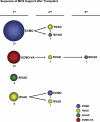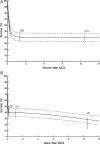Mechanical circulatory support after heart transplantation
- PMID: 21640601
- PMCID: PMC3241119
- DOI: 10.1016/j.ejcts.2011.04.017
Mechanical circulatory support after heart transplantation
Abstract
Objective: Mechanical circulatory support (MCS) may be used for severe graft failure after heart transplantation, but the degree to which it is lifesaving is uncertain.
Methods: Between June 1990 and December 2009, 53 patients after 1417 heart transplants (3.7%) required post-transplant MCS for acute rejection (n=17), biventricular failure (n=16), right ventricular failure (n=16), left ventricular failure (n=1), or respiratory failure (n=3). Although support was occasionally instituted remotely post-transplant (5>1 year), in 39 (73%) instances it was required within 1 week. Initial mode of support was extracorporeal membrane oxygenation in 43 patients (81%), biventricular assist device in 4 (7.5%), and right ventricular assist device in 6 (11%).
Results: Risk of requiring respiratory support was highest in those with restrictive cardiomyopathy as indication for transplant, women, and those with elevated pulmonary pressure or renal failure. Complications of support, which increased progressively with its duration, included stroke in two patients (3.8%), infection in two (3.8%), and reoperation for bleeding (seven instances) in four (7.0%). Nineteen patients (36%) recovered and were removed from support, five (9.4%) underwent retransplantation (four after biventricular failure and one after acute rejection), and 29 died while on support (55%). Overall survival after initiating support was 94%, 83%, 66%, and 43% at 1, 3, 7, and 30 days, respectively. Patients requiring support for biventricular failure had better survival than those having acute rejection or other indications (P=0.03). Survival after retransplantation or removal from support following recovery was 88% at 1 year and 61% at 10 years.
Conclusion: Severe refractory heart failure after transplantation is a rare catastrophic event for which MCS offers the possibility of recovery or bridge to retransplantation, particularly for patients with biventricular failure in the absence of rejection. Early retransplantation should be considered in patients who show no evidence of graft recovery on MCS.
Figures





References
-
- Taylor DO, Edwards LB, Aurora P, Christie JD, Dobbels F, Kirk R, Rahmel AO, Kucheryavaya AY, Hertz MI. Registry of the International Society for Heart and Lung Transplantation: twenty-fifth official adult heart transplant report – 2008. J Heart Lung Transplant. 2008;27:943–56. - PubMed
-
- Russo MJ, Iribarne A, Hong KN, Ramlawi B, Chen JM, Takayama H, Mancini DM, Naka Y. Factors associated with primary graft failure after heart transplantation. Transplantation. 2010;90:444–50. - PubMed
-
- Young JB, Hauptman PJ, Naftel DC, Ewald G, Aaronson K, Dec GW, Taylor DO, Higgins R, Platt L, Kirklin J. Determinants of early graft failure following cardiac transplantation, a 10-year, multi-institutional, multivariable analysis. J Heart Lung Transplant. 2001;20:212. - PubMed
-
- Fernandez AL, Herreros JM, Llorens R, Martinez A, Panizo A, Manito N. Primary graft failure after heart transplantation. Successful recovery with pneumatic biventricular assistance. Int J Artif Organs. 1996;19:307–10. - PubMed
-
- Hooper TL, Odom NJ, Fetherston GJ, Waterhouse P, Hilton CJ, Dark JH. Successful use of left ventricular assist device for primary graft failure after heart transplantation. J Heart Transplant. 1988;7:385–7. - PubMed
Publication types
MeSH terms
LinkOut - more resources
Full Text Sources
Medical

